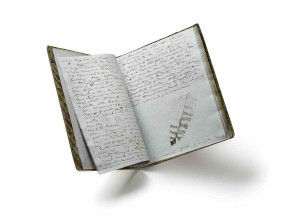The Morgan Library Receives Original Manuscript of Philip Glass' "Einstein on the Beach"
 New York, NY—In 1976 composer Philip Glass and director Robert Wilson redefined opera with the debut in Avignon, France, of Einstein on the Beach. The nearly five-hour, non-narrative work broke a host of operatic conventions and would become the most celebrated of the many collaborations between these two giants of the musical and theatrical stage.
New York, NY—In 1976 composer Philip Glass and director Robert Wilson redefined opera with the debut in Avignon, France, of Einstein on the Beach. The nearly five-hour, non-narrative work broke a host of operatic conventions and would become the most celebrated of the many collaborations between these two giants of the musical and theatrical stage.
Now, Mr. Glass’s autograph score for the landmark work is coming to the Morgan Library & Museum as a bequest from the estate of the late New York collector and philanthropist Paul F. Walter. A longtime supporter of the Morgan who died in January 2017, Mr. Walter also bequeathed the museum scene designs and other items related to the work.
“Many have said that the true starting point of contemporary opera was 1976 with the production of Einstein on the Beach in Avignon,” said Colin B. Bailey, director of the Morgan Library & Museum. “The work was groundbreaking on so many levels, from staging to instrumentation to the choral arrangements. The unrivaled genius of Mr. Glass is evident throughout, and we are deeply grateful to Paul Walter and his estate for generously leaving this work to the Morgan. It is an extraordinary addition to our distinguished collection of music manuscripts.”
In 2010 Mr. Walter placed the Einstein on the Beach manuscript on loan at the Morgan for the benefit of scholarly research. Two years later, in 2012, the museum mounted an exhibition devoted to the work and its stage adaptations.
Mr. Glass eschewed tradition and composed Einstein on the Beach for the synthesizers and woodwinds of the Philip Glass Ensemble in addition to voices and solo violin, instead of the typical orchestral arrangement. Abstract dance sequences, choreographed by Lucinda Childs and Andrew de Groat, were juxtaposed against a sequence of large, recurring images projected on a screen at the back of the stage. The opera’s four acts were framed and connected with a series of short scenes or “knee plays.” Rather than the standard intermission, the audience was free to enter and exit throughout the almost five-hour performance.
The sung portions of the opera use number sequences and solfège syllables (do, re, mi, fa, sol, la, ti); the spoken sections feature texts by Christopher Knowles, Ms. Childs, and actor Samuel M. Johnson. Contemporary events and notable people of the 1970s are referenced in various scenes—from the famous trial of heiress-turned-revolutionary Patty Hearst to the Beatles and pop singer David Cassidy.
Einstein on the Beach was the first of Mr. Glass’s portrait trilogy. It was followed by Satyagraha (1980), in which the composer turned his attention to Gandhi, and Akhnaten (1983), based on the life of the Egyptian pharaoh.
Paul Walter was involved with the Morgan since the late 1970s, when he generously donated a collection of Indian miniature paintings, an area otherwise not represented in the institution’s collections. He was named a Life Fellow in 1979 and later a Benefactor and Fellow in Perpetuity. He was also a founding member of the Morgan’s Modern and Contemporary Collectors Committee which formed in 2006.
Image: Philip Glass (b. 1937), Autograph manuscript, Einstein on the Beach, The Morgan Library & Museum, Bequest of Paul F. Walter. Photography by Anthony Troncale. © Dunvagen Music Publishers.















